
|
It will approach to Sun down to 0.4 a.u. in late September, and it is expected to brighten up to 2 mag. The brightness evolution slowed down since May. But it brightened up to 8.2 mag in mid August (Aug. 12, Thomas Lehmann). Hirohisa Sato reported the comet looks very bright in the SWAN image on Sept. 7. It brightens up to 2 mag, but it will turn to fade out rapidly after that. Now it is not observable. It will appear soon in the Southern Hemisphere, or in October in the Northern Hemisphere.
Date(TT) R.A. (2000) Decl. Delta r Elong. m1 Best Time(A, h)
Sept. 7 10 40.20 -4 9.8 1.619 0.665 11 5.7 4:10 (261,-20)
Sept.14 10 36.57 -5 9.3 1.433 0.536 15 4.8 4:16 (267,-13)
|

|
It returned for the first time in 68 years. It brightened up to 6.2 mag in early summer (July 1, Virgilio Gonano). Now it is 8.3 mag (Sept. 5, Virgilio Gonano). It will fade out rapidly after this. It will be unobservable in October in the Southern Hemisphere, or in November in the Northern Hemisphere. But it will be observable again in January in the Northern Hemisphere.
Date(TT) R.A. (2000) Decl. Delta r Elong. m1 Best Time(A, h)
Sept. 7 13 36.57 15 45.3 2.210 1.559 38 8.8 19:44 ( 96, 18)
Sept.14 13 56.52 12 19.5 2.299 1.625 37 9.2 19:33 ( 93, 17)
|

|
It returns for the first time in 70 years. It brightened up to 3.7 mag in early April (Apr. 6, Jose Guilherme Aguiar). Now it is 10.3 mag (Aug. 29, Chris Wyatt). Fading gradually. In the Northern Hemisphere, it is not observable now. It locates somewhat low in the Southern Hemisphere. But it will become high in winter.
Date(TT) R.A. (2000) Decl. Delta r Elong. m1 Best Time(A, h)
Sept. 7 12 39.83 -47 29.1 2.728 2.349 57 10.8 19:44 ( 49,-27)
Sept.14 13 0.77 -47 31.9 2.871 2.435 54 11.1 19:33 ( 48,-26)
|
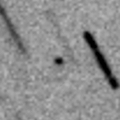
|
It will fade out rapidly after this. In the Northern Hemisphere, it is not observable now, but it will be observable soon. It stays extremely low in the Southern Hemisphere.
Date(TT) R.A. (2000) Decl. Delta r Elong. m1 Best Time(A, h)
Sept. 7 12 20.06 2 29.6 1.909 1.017 19 12.0 19:44 ( 96, -5)
Sept.14 12 51.85 1 41.8 1.955 1.078 20 12.3 19:33 ( 93, -2)
|
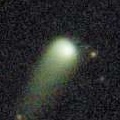
|
Now it is 12.5 mag (Aug. 7, Osamu Miyazaki). It stays 12 mag for a while. In the Northern Hemisphere, it stays observable in good condition. In the Southern Hemisphere, it is not observable now.
Date(TT) R.A. (2000) Decl. Delta r Elong. m1 Best Time(A, h)
Sept. 7 7 36.45 45 14.4 4.077 3.667 59 12.3 4:10 (237, 40)
Sept.14 7 37.50 46 40.1 3.962 3.666 65 12.2 4:16 (237, 46)
|

|
Now it is 13.1 mag (Aug. 29, Chris Wyatt). It stays 13 mag for a while. It stays extremely low in the Northern Hemisphere. But it will become high in spring. In the Southern Hemisphere, it will be getting lower gradually after this, and it will be unobservable in December.
Date(TT) R.A. (2000) Decl. Delta r Elong. m1 Best Time(A, h)
Sept. 7 16 42.51 -45 40.6 2.270 2.496 90 12.8 19:44 ( 22, 4)
Sept.14 16 54.74 -43 17.8 2.325 2.473 86 12.8 19:33 ( 24, 6)
|

|
It became much brighter than expected. Now it is 13.8 mag (Sept. 8, Michael Jager). Fading slowly. It locates somewhat low in the Northern Hemisphere. But it will become high in winter. In the Southern Hemisphere, it is not observable now.
Date(TT) R.A. (2000) Decl. Delta r Elong. m1 Best Time(A, h)
Sept. 7 9 25.73 48 24.1 2.201 1.685 47 13.8 4:10 (227, 24)
Sept.14 10 2.48 49 24.3 2.133 1.664 49 13.7 4:16 (225, 24)
|
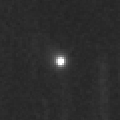
|
Now it is 13.8 mag (Aug. 31, Chris Wyatt). Fading slowly. It stays extremely low in the Northern Hemisphere. In the Southern Hemisphere, it will be getting lower gradually after this, and it will be unobservable in January.
Date(TT) R.A. (2000) Decl. Delta r Elong. m1 Best Time(A, h)
Sept. 7 15 5.84 -24 4.1 1.775 1.653 66 13.9 19:44 ( 50, 10)
Sept.14 15 25.58 -24 43.6 1.808 1.640 64 13.9 19:33 ( 49, 11)
|
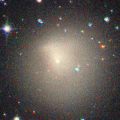
|
In the Northern Hemisphere, it will be getting higher gradually. In the Southern Hemisphere, it is not observable now, but it will be observable soon.
Date(TT) R.A. (2000) Decl. Delta r Elong. m1 Best Time(A, h)
Sept. 7 9 32.98 13 47.2 7.141 6.229 23 14.2 4:10 (256, 4)
Sept.14 9 37.69 13 19.6 7.091 6.230 29 14.2 4:16 (261, 10)
|

|
Now it is 14.1 mag (Aug. 29, Chris Wyatt). It stays 14 mag for a while. In the Northern Hemisphere, it is not observable now, but it will appear in November. In the Southern Hemisphere, it will be unobservable in October. But it will be observable again in December.
Date(TT) R.A. (2000) Decl. Delta r Elong. m1 Best Time(A, h)
Sept. 7 13 5.42 -18 51.6 5.723 4.982 39 14.3 19:44 ( 72, -8)
Sept.14 13 12.40 -18 49.5 5.785 4.983 33 14.3 19:33 ( 74,-10)
|

|
It brightened very rapidly up to 10.0 mag in June (June 11, Virgilio Gonano). Now it is 13.8 mag (Aug. 23, Ken-ichi Kadota). Fading rapidly. It will be fainter than 18 mag in November. It will be unobservable in October in the Southern Hemisphere, or in November in the Northern Hemisphere.
Date(TT) R.A. (2000) Decl. Delta r Elong. m1 Best Time(A, h)
Sept. 7 13 56.73 23 16.3 2.465 1.894 45 14.3 19:44 (101, 26)
Sept.14 14 10.71 19 53.1 2.588 1.974 42 14.7 19:33 ( 98, 24)
|
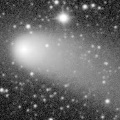
|
It brightened up to 9.6 mag from February to March (Feb. 25, Thomas Lehmann). Now it is 13.3 mag (Sept. 5, Osamu Miyazaki). Fading gradually. In the Northern Hemisphere, it stays observable in good condition. In the Southern Hemisphere, it will be unobservable in November.
Date(TT) R.A. (2000) Decl. Delta r Elong. m1 Best Time(A, h)
Sept. 7 19 21.12 52 47.4 2.634 3.052 104 14.4 20:13 (180, 72)
Sept.14 19 23.65 50 52.2 2.711 3.126 104 14.6 19:48 (180, 74)
|

|
It is expected to brighten up to 13 mag in 2025 autumn, and it will be observable in good condition. Now it is 14.1 mag (Aug. 31, Chris Wyatt). It stays 15 mag for a while. It stays observable in good condition.
Date(TT) R.A. (2000) Decl. Delta r Elong. m1 Best Time(A, h)
Sept. 7 22 49.43 -4 33.4 3.752 4.758 176 14.6 23:41 ( 0, 51)
Sept.14 22 46.49 -4 45.5 3.731 4.723 169 14.6 23:11 ( 0, 50)
|

|
Now it is 14.2 mag (Sept. 1, Thomas Lehmann). Fading gradually. In the Northern Hemisphere, it stays observable in good condition. It stays extremely low in the Southern Hemisphere.
Date(TT) R.A. (2000) Decl. Delta r Elong. m1 Best Time(A, h)
Sept. 7 7 37.57 36 11.3 2.188 1.821 55 14.7 4:10 (248, 38)
Sept.14 7 55.58 35 46.1 2.175 1.861 58 15.2 4:16 (250, 41)
|
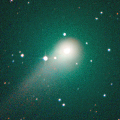
|
It was observed at 9-10 mag for a long time in 2023. Now it is 14.0 mag (Aug. 31, Chris Wyatt). Fading slowly. In the Northern Hemisphere, it will never be observable after this. In the Southern Hemisphere, it stays observable in good condition.
Date(TT) R.A. (2000) Decl. Delta r Elong. m1 Best Time(A, h)
Sept. 7 22 34.07 -70 42.6 4.948 5.454 115 14.8 23:25 ( 0,-16)
Sept.14 22 14.27 -70 51.2 5.061 5.510 111 14.9 22:38 ( 0,-16)
|
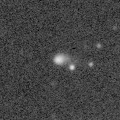
|
Now it is 15.6 mag (Aug. 18, ATLAS-HKO, Haleakala). It stays 15 mag for a while. It stays observable in good condition.
Date(TT) R.A. (2000) Decl. Delta r Elong. m1 Best Time(A, h)
Sept. 7 6 30.94 3 21.0 6.411 6.102 67 15.0 4:10 (294, 35)
Sept.14 6 34.45 3 17.2 6.293 6.080 73 15.0 4:16 (300, 40)
|

|
Now it is 14.3 mag (Sept. 1, Thomas Lehmann). Fading gradually. It will be fainter than 18 mag in January. It stays observable in good condition.
Date(TT) R.A. (2000) Decl. Delta r Elong. m1 Best Time(A, h)
Sept. 7 2 42.93 8 18.0 1.465 2.187 123 15.1 3:38 ( 0, 63)
Sept.14 2 42.68 8 15.0 1.431 2.217 130 15.2 3:11 ( 0, 63)
|

|
Now it is 14.5 mag (Aug. 20, Ken-ichi Kadota). It will fade out rapidly after this. It will be fainter than 18 mag in December. In the Northern Hemisphere, it stays observable in good condition.
Date(TT) R.A. (2000) Decl. Delta r Elong. m1 Best Time(A, h)
Sept. 7 5 16.47 13 36.5 1.154 1.469 85 15.3 4:10 (300, 55)
Sept.14 5 30.41 15 52.7 1.127 1.491 88 15.5 4:16 (304, 60)
|
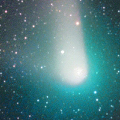
|
It brightened up to 8 mag from 2022 summer to 2023 spring. Now it is 15.4 mag (Aug. 17, Hiroshi Abe). It stays 16 mag for a while. In the Northern Hemisphere, it stays observable in good condition.
Date(TT) R.A. (2000) Decl. Delta r Elong. m1 Best Time(A, h)
Sept. 7 6 25.18 17 29.1 7.025 6.723 68 15.4 4:10 (280, 44)
Sept.14 6 26.19 17 39.4 6.967 6.780 75 15.4 4:16 (286, 51)
|

|
It approaches to Sun down to 0.09 a.u. on Jan. 13, 2025. According to the calculation, it will brighten up to -1 mag. But probably, it will be disintegrated. At the high light, it may be observable after the perihelion passage only in the Southern Hemisphere. Now it is 15.7 mag (Aug. 31, ATLAS South Africa). It will brighten rapidly after this. In the Northern Hemisphere, it will never be observable after this. In the Southern Hemisphere, it will be getting lower gradually after this, and it will be unobservable in December.
Date(TT) R.A. (2000) Decl. Delta r Elong. m1 Best Time(A, h)
Sept. 7 13 30.28 -52 8.9 2.957 2.710 66 15.7 19:44 ( 40,-22)
Sept.14 13 38.99 -50 50.7 2.942 2.608 61 15.5 19:33 ( 42,-22)
|
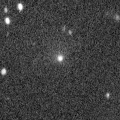
|
Very large comet. It is expected to brighten up to 13 mag in 2031. Now it is 15.0 mag (Aug. 16, Thomas Lehmann). It stays 15 mag for a while. In the Northern Hemisphere, it is not observable now. In the Southern Hemisphere, it stays observable in good condition. In the Northern Hemisphere, it is not observable until 2030.
Date(TT) R.A. (2000) Decl. Delta r Elong. m1 Best Time(A, h)
Sept. 7 4 21.90 -66 56.4 15.783 15.982 99 15.5 4:10 (353,-13)
Sept.14 4 22.18 -67 26.2 15.763 15.959 99 15.5 4:16 (357,-13)
|
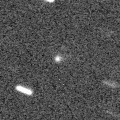
|
Now it is 16.5 mag (Apr. 3, Taras Prystavski). It stays 16 mag for a while. It locates somewhat low in the Northern Hemisphere. But it will become high in winter. In the Southern Hemisphere, it is not observable now, but it will appear in November.
Date(TT) R.A. (2000) Decl. Delta r Elong. m1 Best Time(A, h)
Sept. 7 9 58.20 14 18.3 2.754 1.822 17 15.6 4:10 (252, 0)
Sept.14 10 16.17 13 0.4 2.741 1.830 20 15.6 4:16 (256, 2)
|

|
Now it is 15.6 mag (July 24, Thomas Lehmann). It stays 16 mag for a while. In the Northern Hemisphere, it is not observable now, but it will appear in October. In the Southern Hemisphere, it will be getting higher gradually.
Date(TT) R.A. (2000) Decl. Delta r Elong. m1 Best Time(A, h)
Sept. 7 9 54.10 -25 50.9 4.023 3.262 36 15.6 4:10 (287,-22)
Sept.14 9 55.05 -26 44.1 4.041 3.302 37 15.6 4:16 (292,-16)
|
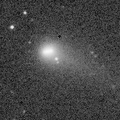
|
It brightened up to 13.5 mag in winter (Dec. 5, Chris Wyatt). Fading slowly. Now it is not observable. It will appear in October in the Northern Hemisphere, or in November in the Southern Hemisphere.
Date(TT) R.A. (2000) Decl. Delta r Elong. m1 Best Time(A, h)
Sept. 7 11 9.00 12 38.7 3.363 2.365 6 15.9 19:44 (115,-13)
Sept.14 11 22.21 11 12.6 3.388 2.396 7 16.0 4:16 (247,-12)
|

|
Now it is 16.4 mag (Aug. 20, Ken-ichi Kadota). It stays 15 mag for a while. In the Northern Hemisphere, it stays observable in good condition. In the Southern Hemisphere, it is not observable now.
Date(TT) R.A. (2000) Decl. Delta r Elong. m1 Best Time(A, h)
Sept. 7 5 18.00 53 56.0 2.667 2.732 82 16.0 4:10 (219, 61)
Sept.14 5 34.27 55 46.9 2.580 2.708 86 15.9 4:16 (213, 62)
|
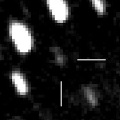
|
The condition is bad in this apparition. It must have brightened up to 10 mag in early summer, however, it is not observable at all. Fading rapidly. It will be fainter than 18 mag in October. It will never be observable after this.
Date(TT) R.A. (2000) Decl. Delta r Elong. m1 Best Time(A, h)
Sept. 7 11 22.17 12 8.7 2.729 1.736 7 15.9 19:44 (113,-11)
Sept.14 11 38.70 10 30.8 2.788 1.796 7 16.4 19:33 (111,-12)
|

|
First return of a new periodic comet which brightened up to 16 mag in 2012. It is expected to brighten rapidly up to 14.5 mag in autumn. Now it is 18.5 mag (July 25, Hidetaka Sato). Brightening slowly. In the Northern Hemisphere, it stays observable in good condition. In the Southern Hemisphere, it will be getting lower gradually after this, and it will be unobservable in December.
Date(TT) R.A. (2000) Decl. Delta r Elong. m1 Best Time(A, h)
Sept. 7 4 27.07 4 0.5 1.433 1.869 98 16.3 4:10 (328, 55)
Sept.14 4 33.96 6 16.2 1.346 1.854 103 16.0 4:16 (337, 59)
|

|
It approached to Sun down to 0.12 a.u. on Aug. 4. Fading rapidly. It will be fainter than 18 mag soon. In the Northern Hemisphere, it will never be observable after this. In the Southern Hemisphere, it stays observable in good condition.
Date(TT) R.A. (2000) Decl. Delta r Elong. m1 Best Time(A, h)
Sept. 7 6 50.40 -45 29.5 0.226 0.979 76 16.2 4:10 (324, -4)
Sept.14 3 17.59 -62 34.6 0.266 1.115 107 17.1 3:52 ( 0, -7)
|

|
It is expected to brighten up to 13.5 mag, and it will be observable in good condition in winter. Now it is 17.0 mag (Aug. 31, ATLAS Chile). Brightening gradually. In the Northern Hemisphere, it will be getting higher gradually. In the Southern Hemisphere, it stays observable in good condition.
Date(TT) R.A. (2000) Decl. Delta r Elong. m1 Best Time(A, h)
Sept. 7 6 36.00 -28 16.4 1.986 1.944 72 16.4 4:10 (316, 11)
Sept.14 6 42.18 -27 25.4 1.891 1.903 75 16.2 4:16 (321, 15)
|

|
Brightened rapidly. Now it is 16.0 mag (Aug. 26, Hirohisa Sato). Fading gradually. It will be fainter than 18 mag in November. It stays observable in good condition.
Date(TT) R.A. (2000) Decl. Delta r Elong. m1 Best Time(A, h)
Sept. 7 22 1.85 -3 37.6 1.372 2.359 164 16.2 22:51 ( 0, 51)
Sept.14 21 27.65 -6 19.9 1.432 2.357 149 16.3 21:50 ( 0, 49)
|
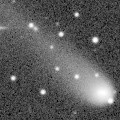
|
It stays 17 mag for a while. In the Northern Hemisphere, it is not observable now, but it will be observable soon. In the Southern Hemisphere, it stays observable in good condition.
Date(TT) R.A. (2000) Decl. Delta r Elong. m1 Best Time(A, h)
Sept. 7 7 55.34 -37 26.4 6.211 5.800 61 16.2 4:10 (311, -7)
Sept.14 7 55.98 -38 25.7 6.209 5.844 64 16.3 4:16 (316, -3)
|
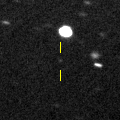
|
Now it is 16.2 mag (Aug. 30, ATLAS-HKO, Haleakala). It stays 16 mag for a while. It stays observable in good condition.
Date(TT) R.A. (2000) Decl. Delta r Elong. m1 Best Time(A, h)
Sept. 7 6 6.37 15 34.2 3.563 3.410 73 16.3 4:10 (286, 47)
Sept.14 6 13.37 15 10.0 3.477 3.416 78 16.2 4:16 (292, 52)
|

|
It brightened very rapidly in outburst in late May. Now it is 16.7 mag (Aug. 24, ATLAS Chile). Fading slowly. It will be unobservable in November.
Date(TT) R.A. (2000) Decl. Delta r Elong. m1 Best Time(A, h)
Sept. 7 16 2.29 -22 39.9 3.271 3.225 78 16.3 19:44 ( 41, 20)
Sept.14 16 10.12 -22 43.6 3.371 3.232 73 16.4 19:33 ( 43, 19)
|
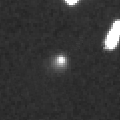
|
Now it is 16.6 mag (Aug. 2, ATLAS South Africa). It stays 16 mag for a while. It locates somewhat low in the Northern Hemisphere. In the Southern Hemisphere, it stays observable in good condition.
Date(TT) R.A. (2000) Decl. Delta r Elong. m1 Best Time(A, h)
Sept. 7 6 53.19 -25 38.1 7.287 6.979 68 16.5 4:10 (312, 10)
Sept.14 6 56.82 -26 3.1 7.211 6.963 71 16.4 4:16 (317, 14)
|
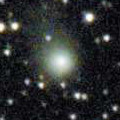
|
It brightened up to 12.1 mag in 2023 spring (May 20, 2023, Jose Guilherme de S. Aguiar). Now it is 16.6 mag (Aug. 11, ATLAS Chile). It stays 17 mag for a while. It stays extremely low in the Northern Hemisphere. In the Southern Hemisphere, it stays observable in good condition.
Date(TT) R.A. (2000) Decl. Delta r Elong. m1 Best Time(A, h)
Sept. 7 6 57.57 -36 51.0 5.665 5.429 71 16.4 4:10 (319, 1)
Sept.14 6 59.42 -37 18.3 5.664 5.477 74 16.5 4:16 (324, 5)
|
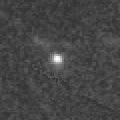
|
Now it is 17.5 mag (Mar. 9, Toshihiko Ikemura, Hirohisa Sato). Brightening slowly. In the Northern Hemisphere, it stays observable in good condition. It locates somewhat low in the Southern Hemisphere. But it will become high in winter.
Date(TT) R.A. (2000) Decl. Delta r Elong. m1 Best Time(A, h)
Sept. 7 7 36.26 26 59.2 3.288 2.805 53 16.5 4:10 (259, 34)
Sept.14 7 47.63 26 29.6 3.199 2.791 57 16.4 4:16 (262, 39)
|

|
Now it is 17.3 mag (May 6, ATLAS Chile). Brightening slowly. It locates somewhat low in the Northern Hemisphere. But it will become high in winter. In the Southern Hemisphere, it stays observable in good condition.
Date(TT) R.A. (2000) Decl. Delta r Elong. m1 Best Time(A, h)
Sept. 7 7 59.99 -25 53.8 5.071 4.564 54 16.6 4:10 (302, -1)
Sept.14 8 4.00 -25 54.7 4.995 4.533 57 16.6 4:16 (306, 4)
|

|
Now it is 16.9 mag (Aug. 23, ATLAS South Africa). It stays 17 mag for a while. In the Northern Hemisphere, it is not observable now, but it will appear in December. It locates somewhat low in the Southern Hemisphere. But it will become high in winter.
Date(TT) R.A. (2000) Decl. Delta r Elong. m1 Best Time(A, h)
Sept. 7 13 24.28 -39 40.1 5.806 5.311 56 16.6 19:44 ( 52,-16)
Sept.14 13 25.34 -39 26.5 5.881 5.300 50 16.6 19:33 ( 54,-18)
|

|
Now it is 16.3 mag (Sept. 1, ATLAS Chile). It will fade out rapidly after this. It will be fainter than 18 mag in November. It stays observable in good condition.
Date(TT) R.A. (2000) Decl. Delta r Elong. m1 Best Time(A, h)
Sept. 7 23 37.01 -20 36.1 1.533 2.515 163 16.6 0:33 ( 0, 35)
Sept.14 23 31.00 -20 39.9 1.559 2.537 162 16.7 23:55 ( 0, 34)
|
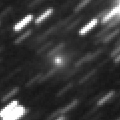
|
Very far object. Now it is 17.0 mag (Sept. 1, ATLAS South Africa). It stays 17 mag for a while. In the Northern Hemisphere, it is not observable now. In the Southern Hemisphere, it stays observable in good condition.
Date(TT) R.A. (2000) Decl. Delta r Elong. m1 Best Time(A, h)
Sept. 7 2 40.34 -68 38.7 10.078 10.434 108 16.7 3:35 ( 0,-14)
Sept.14 2 33.31 -69 1.3 10.091 10.440 107 16.7 3:01 ( 0,-14)
|
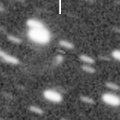
|
Now it is 16.7 mag (Aug. 27, S. Shurpakov). It stays 17 mag for a while. In the Northern Hemisphere, it stays observable in good condition. In the Southern Hemisphere, it will be unobservable in November.
Date(TT) R.A. (2000) Decl. Delta r Elong. m1 Best Time(A, h)
Sept. 7 19 34.82 39 1.3 3.914 4.422 114 16.7 20:26 (180, 86)
Sept.14 19 26.47 36 49.6 3.980 4.441 111 16.8 19:51 (180, 88)
|

|
Now it is 17.4 mag (Sept. 1, ATLAS-HKO, Haleakala). It will fade out rapidly after this. It will be fainter than 18 mag in October. In the Northern Hemisphere, it stays observable in good condition. It stays extremely low in the Southern Hemisphere.
Date(TT) R.A. (2000) Decl. Delta r Elong. m1 Best Time(A, h)
Sept. 7 6 28.92 29 51.3 2.069 1.939 68 16.8 4:10 (263, 49)
Sept.14 6 41.55 31 3.4 2.047 1.992 72 16.9 4:16 (264, 54)
|

|
Now it is 17.3 mag (Aug. 29, ATLAS-MLO, Mauna Loa). Fading slowly. It will be fainter than 18 mag in January. It stays observable in good condition.
Date(TT) R.A. (2000) Decl. Delta r Elong. m1 Best Time(A, h)
Sept. 7 0 58.28 0 50.5 1.118 2.055 150 16.9 1:54 ( 0, 56)
Sept.14 0 57.18 0 9.6 1.081 2.047 157 16.8 1:25 ( 0, 55)
|
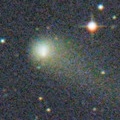
|
It brightened up to 11.1 mag in early 2022 (Mar. 31, 2022, F. Kugel, J.-G. Bosch, J. Nicolas). Now it is 16.4 mag (Aug. 31, ATLAS-MLO, Mauna Loa). It stays 17 mag for a while. In the Northern Hemisphere, it stays observable in good condition. In the Southern Hemisphere, it will be unobservable in November.
Date(TT) R.A. (2000) Decl. Delta r Elong. m1 Best Time(A, h)
Sept. 7 17 14.40 28 51.7 7.607 7.665 89 16.9 19:44 ( 80, 69)
Sept.14 17 15.96 28 17.0 7.716 7.706 85 16.9 19:33 ( 82, 65)
|
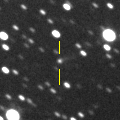
|
It stays 17 mag for a while. In the Northern Hemisphere, it stays observable in good condition. In the Southern Hemisphere, it will be getting higher gradually.
Date(TT) R.A. (2000) Decl. Delta r Elong. m1 Best Time(A, h)
Sept. 7 7 39.23 14 17.7 5.412 4.837 50 16.9 4:10 (272, 28)
Sept.14 7 44.67 13 29.5 5.330 4.841 56 16.9 4:16 (277, 33)
|

|
Now it is 17.0 mag (Sept. 1, ATLAS-HKO, Haleakala). It stays 17 mag for a while. In the Northern Hemisphere, it stays observable in good condition. In the Southern Hemisphere, it will be unobservable in December.
Date(TT) R.A. (2000) Decl. Delta r Elong. m1 Best Time(A, h)
Sept. 7 23 26.98 31 30.3 5.320 6.145 141 17.0 0:23 ( 0, 87)
Sept.14 23 18.79 31 2.3 5.245 6.101 145 17.0 23:43 ( 0, 86)
|

|
Now it is 16.9 mag (Aug. 14, ATLAS-MLO, Mauna Loa). It will fade out rapidly after this. It will be fainter than 18 mag in November. In the Northern Hemisphere, it stays observable in good condition. It stays extremely low in the Southern Hemisphere.
Date(TT) R.A. (2000) Decl. Delta r Elong. m1 Best Time(A, h)
Sept. 7 3 42.72 38 16.0 1.434 1.912 101 17.0 4:10 (238, 83)
Sept.14 3 51.67 40 19.1 1.391 1.926 105 17.1 4:16 (187, 85)
|

|
It will brighten up to 14 mag in 2025 spring. Now it is 17.5 mag (Sept. 1, ATLAS Chile). It stays 17 mag for a while. It locates somewhat low in the Northern Hemisphere. In the Southern Hemisphere, it stays observable in good condition.
Date(TT) R.A. (2000) Decl. Delta r Elong. m1 Best Time(A, h)
Sept. 7 0 18.86 -24 39.8 1.613 2.557 154 17.2 1:15 ( 0, 31)
Sept.14 0 13.81 -26 12.1 1.564 2.510 154 17.1 0:42 ( 0, 29)
|

|
Now it is 16.8 mag (Aug. 25, ATLAS Chile). It stays 17 mag for a while. It locates somewhat low in the Northern Hemisphere. But it will become high in summer. In the Southern Hemisphere, it will be getting lower gradually after this, and it will be unobservable in January.
Date(TT) R.A. (2000) Decl. Delta r Elong. m1 Best Time(A, h)
Sept. 7 18 52.70 -22 20.3 2.803 3.390 117 17.1 19:46 ( 0, 33)
Sept.14 18 54.39 -22 28.1 2.886 3.383 111 17.2 19:33 ( 4, 32)
|
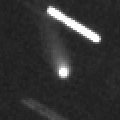
|
It has started fading before the perihelion passage. Now it is 17.0 mag (Aug. 11, Thomas Lehmann). Fading slowly. It will be fainter than 18 mag in November. In the Northern Hemisphere, it will never be observable after this. It locates somewhat low in the Southern Hemisphere.
Date(TT) R.A. (2000) Decl. Delta r Elong. m1 Best Time(A, h)
Sept. 7 10 16.89 -64 50.7 2.963 2.810 71 17.2 4:10 (329,-38)
Sept.14 10 52.04 -64 46.7 3.033 2.824 68 17.3 4:16 (329,-38)
|

|
Now it is 17.5 mag (Aug. 30, ATLAS South Africa). It stays 17 mag for a while. It stays observable in good condition.
Date(TT) R.A. (2000) Decl. Delta r Elong. m1 Best Time(A, h)
Sept. 7 22 52.60 -6 35.6 1.216 2.224 177 17.4 23:44 ( 0, 49)
Sept.14 22 48.02 -6 52.6 1.203 2.200 169 17.2 23:12 ( 0, 48)
|

|
Now it is 17.5 mag (Sept. 1, ATLAS-HKO, Haleakala). It stays 17 mag for a while. It stays observable in good condition.
Date(TT) R.A. (2000) Decl. Delta r Elong. m1 Best Time(A, h)
Sept. 7 2 23.61 21 54.2 2.647 3.311 123 17.4 3:19 ( 0, 77)
Sept.14 2 23.43 21 55.6 2.543 3.283 130 17.3 2:51 ( 0, 77)
|
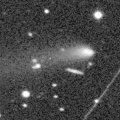
|
It brightened up to 14 mag in early 2023 and 2023 autumn. Now it is 17.2 mag (Aug. 27, A. Diepvens). Fading slowly. It will be fainter than 18 mag in October. In the Northern Hemisphere, it stays observable in good condition.
Date(TT) R.A. (2000) Decl. Delta r Elong. m1 Best Time(A, h)
Sept. 7 20 45.89 20 6.0 4.551 5.335 137 17.3 21:38 ( 0, 75)
Sept.14 20 38.55 19 17.6 4.650 5.382 132 17.4 21:03 ( 0, 74)
|

|
Now it is 16.1 mag (June 5, Toshiyuki Takahashi). It stays 18 mag for a while. It will be unobservable in November in the Southern Hemisphere, or in December in the Northern Hemisphere.
Date(TT) R.A. (2000) Decl. Delta r Elong. m1 Best Time(A, h)
Sept. 7 15 48.50 -6 19.3 3.020 2.878 72 17.4 19:44 ( 55, 30)
Sept.14 15 57.08 -6 59.1 3.105 2.882 67 17.4 19:33 ( 56, 29)
|

|
Now it is 17.3 mag (Aug. 31, ATLAS Chile). It stays 17 mag for a while. It will be unobservable soon in the Northern Hemisphere, or in November in the Southern Hemisphere. But it will be observable again in December.
Date(TT) R.A. (2000) Decl. Delta r Elong. m1 Best Time(A, h)
Sept. 7 15 6.16 -29 57.3 4.097 3.842 68 17.4 19:44 ( 46, 6)
Sept.14 15 4.45 -29 32.6 4.193 3.814 61 17.4 19:33 ( 50, 4)
|

|
Now it is 17.4 mag (Aug. 30, ATLAS-MLO, Mauna Loa). Fading slowly. It will be fainter than 18 mag in November. In the Northern Hemisphere, it stays observable in good condition. It locates somewhat low in the Southern Hemisphere.
Date(TT) R.A. (2000) Decl. Delta r Elong. m1 Best Time(A, h)
Sept. 7 2 49.39 26 16.1 1.670 2.302 116 17.5 3:45 ( 0, 81)
Sept.14 2 49.63 28 9.3 1.609 2.308 122 17.4 3:18 ( 0, 83)
|

|
Now it is 17.3 mag (Aug. 29, B. Kumar). It stays 18 mag for a while. In the Northern Hemisphere, it stays observable in good condition. In the Southern Hemisphere, it is not observable now, but it will appear in October.
Date(TT) R.A. (2000) Decl. Delta r Elong. m1 Best Time(A, h)
Sept. 7 8 4.33 36 0.2 2.679 2.184 50 17.5 4:10 (246, 33)
Sept.14 8 20.19 35 32.0 2.650 2.212 53 17.6 4:16 (248, 36)
|
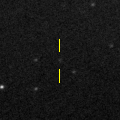
|
Now it is 19.0 mag (Aug. 11, W. Hasubick). It stays 17 mag for a while. It stays observable in good condition.
Date(TT) R.A. (2000) Decl. Delta r Elong. m1 Best Time(A, h)
Sept. 7 4 16.31 -5 43.5 3.666 4.002 102 17.6 4:10 (337, 47)
Sept.14 4 18.93 -6 43.3 3.578 3.998 107 17.5 4:16 (349, 48)
|
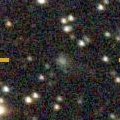
|
Now it is 17.6 mag (Apr. 11, Mt. Lemmon Survey). It stays 18 mag for a while. In the Northern Hemisphere, it stays observable in good condition. It stays extremely low in the Southern Hemisphere.
Date(TT) R.A. (2000) Decl. Delta r Elong. m1 Best Time(A, h)
Sept. 7 7 16.78 38 47.6 7.322 6.881 60 17.6 4:10 (247, 42)
Sept.14 7 21.56 38 52.5 7.239 6.891 66 17.6 4:16 (248, 48)
|

|
Now it is 17.5 mag (Sept. 1, ATLAS Chile). It stays 17 mag for a while. It will be unobservable in December. It is expected to brighten up to 13 mag in 2026, and it will be observable in excellent condition in the Northern Hemisphere. In the Southern Hemisphere, it locates very low at the high light.
Date(TT) R.A. (2000) Decl. Delta r Elong. m1 Best Time(A, h)
Sept. 7 18 23.80 -38 28.9 7.190 7.587 109 17.6 19:44 ( 6, 16)
Sept.14 18 22.64 -37 55.4 7.256 7.543 102 17.6 19:33 ( 9, 16)
|
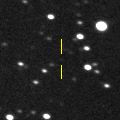
|
Now it is 17.7 mag (Sept. 1, ATLAS Chile). Brightening gradually. It will be unobservable in December. It will brighten up to 14.5 mag in 2025 spring. But the condition is bad.
Date(TT) R.A. (2000) Decl. Delta r Elong. m1 Best Time(A, h)
Sept. 7 15 53.18 -14 40.1 2.474 2.415 74 17.9 19:44 ( 48, 25)
Sept.14 16 2.37 -15 40.8 2.529 2.388 70 17.7 19:33 ( 49, 23)
|
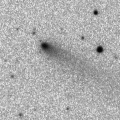
|
Now it is 18.6 mag (Aug. 29, D. Buczynski). It stays 18 mag for a while. It stays observable in good condition.
Date(TT) R.A. (2000) Decl. Delta r Elong. m1 Best Time(A, h)
Sept. 7 3 39.27 16 57.5 3.998 4.414 107 17.8 4:10 (341, 71)
Sept.14 3 39.41 17 1.2 3.911 4.427 114 17.8 4:07 ( 0, 72)
|

|
First return of a new periodic comet which brightened up to 15 mag in 2010. Now it is 18.8 mag (Aug. 13, John Maikner). It stays 18 mag for a while. In the Northern Hemisphere, it stays observable in good condition. It stays extremely low in the Southern Hemisphere.
Date(TT) R.A. (2000) Decl. Delta r Elong. m1 Best Time(A, h)
Sept. 7 7 12.34 31 26.9 2.153 1.856 59 17.9 4:10 (256, 41)
Sept.14 7 30.82 31 21.8 2.122 1.877 62 17.8 4:16 (258, 44)
|

|
Now it is 17.3 mag (Aug. 24, ATLAS Chile). Fading gradually. It stays observable in good condition.
Date(TT) R.A. (2000) Decl. Delta r Elong. m1 Best Time(A, h)
Sept. 7 21 12.30 -14 38.0 1.330 2.267 151 17.9 22:05 ( 0, 40)
Sept.14 21 10.74 -15 24.5 1.416 2.307 144 18.1 21:36 ( 0, 40)
|

|
It will brighten up to 16 mag and will be observable in good condition in winter. Now it is 18.6 mag (Aug. 28, W. Hasubick). Brightening slowly. It stays observable in good condition.
Date(TT) R.A. (2000) Decl. Delta r Elong. m1 Best Time(A, h)
Sept. 7 21 29.10 14 48.1 0.702 1.648 148 18.2 22:21 ( 0, 70)
Sept.14 21 26.66 14 28.2 0.678 1.609 144 17.9 21:51 ( 0, 70)
|

|
Now it is 17.4 mag (Aug. 3, ATLAS South Africa). It stays 18 mag for a while. It stays extremely low in the Northern Hemisphere. But it will become high in spring. In the Southern Hemisphere, it will be getting lower gradually.
Date(TT) R.A. (2000) Decl. Delta r Elong. m1 Best Time(A, h)
Sept. 7 15 52.80 -33 37.2 4.581 4.498 78 17.9 19:44 ( 36, 10)
Sept.14 15 59.44 -33 20.1 4.669 4.490 73 18.0 19:33 ( 38, 9)
|
|
![]()
 C/2024 M1 ( ATLAS )
C/2024 M1 ( ATLAS ) C/2023 TD22 ( Lemmon )
C/2023 TD22 ( Lemmon ) C/2019 U5 ( PanSTARRS )
C/2019 U5 ( PanSTARRS ) 472P/2023 RL75 ( NEAT-LINEAR )
472P/2023 RL75 ( NEAT-LINEAR ) 299P/Catalina-PanSTARRS
299P/Catalina-PanSTARRS C/2022 R6 ( PanSTARRS )
C/2022 R6 ( PanSTARRS ) C/2020 K1 ( PanSTARRS )
C/2020 K1 ( PanSTARRS ) P/2023 S1
P/2023 S1 C/2024 A1 ( ATLAS )
C/2024 A1 ( ATLAS ) C/2023 F3 ( ATLAS )
C/2023 F3 ( ATLAS ) 89P/Russell 2
89P/Russell 2 C/2019 E3 ( ATLAS )
C/2019 E3 ( ATLAS ) C/2022 U1 ( Leonard )
C/2022 U1 ( Leonard ) 192P/Shoemaker-Levy 1
192P/Shoemaker-Levy 1 253P/PanSTARRS
253P/PanSTARRS C/2019 T4 ( ATLAS )
C/2019 T4 ( ATLAS ) C/2022 U3 ( Bok )
C/2022 U3 ( Bok ) C/2023 R1 ( PanSTARRS )
C/2023 R1 ( PanSTARRS ) 328P/LONEOS-Tucker
328P/LONEOS-Tucker 49P/Arend-Rigaux
49P/Arend-Rigaux 302P/Lemmon-PanSTARRS
302P/Lemmon-PanSTARRS C/2022 S4 ( Lemmon )
C/2022 S4 ( Lemmon ) 190P/Mueller
190P/Mueller 43P/Wolf-Harrington
43P/Wolf-Harrington C/2021 X1 ( Maury-Attard )
C/2021 X1 ( Maury-Attard ) 362P/(457175) 2008 GO98
362P/(457175) 2008 GO98 C/2024 L5 ( ATLAS )
C/2024 L5 ( ATLAS ) 338P/McNaught
338P/McNaught 50P/Arend
50P/Arend 242P/Spahr
242P/Spahr C/2021 S4 ( Tsuchinshan )
C/2021 S4 ( Tsuchinshan ) C/2024 J3 ( ATLAS )
C/2024 J3 ( ATLAS ) 48P/Johnson
48P/Johnson 117P/Helin-Roman-Alu 1
117P/Helin-Roman-Alu 1 P/2024 O3 ( LINEAR )
P/2024 O3 ( LINEAR ) 125P/Spacewatch
125P/Spacewatch 305P/Skiff
305P/Skiff C/2023 H1 ( PanSTARRS )
C/2023 H1 ( PanSTARRS )![]()





























































